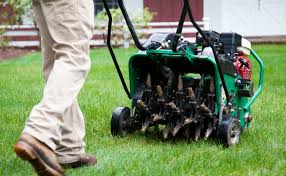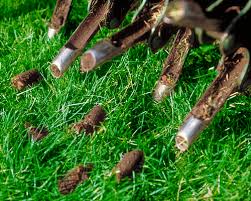CORE AERATION AND OVER SEEDING
What is core aeration?
Most experts will say core aeration is the healthiest service a lawn can receive. If you have seen almost any golf course or healthy lawn, you know what the results look like. Bright, green healthy grass, and lots of it, are the result of the process called core aeration. You will also hear it called lawn aeration since the process is performed on your lawn.
Over time, the soil under your lawn becomes compacted. As the soil compacts, and thatch grows between your grass and soil layer, the grass roots cannot grow as deep. Strong, deep grass roots produce the healthiest looking lawns. To break it down, simply, core aeration uses a machine that produces holes (cylindrical divots, similar to coring an apple) in your lawn. The ‘holes’ allow the remaining soil to decompress when it rains. In a few weeks, your lawn is able to become stronger and healthier as the grass roots go deeper into the soil.
What are the other benefits of lawn aeration?
- With holes pierced into the surface of the lawn, water and fertilizer can be used more efficiently by the lawn.
- Thatch, the thick buildup under your grass, above your soil, is minimized.
- Core Aeration eliminates most soil compaction. (Soil compaction prevents grass roots from growing as deep.)
- Once soil is loosened, lawn aeration means grass roots can grow deeper and stronger. The stronger, healthier grass can withstand more impact.
- As a result of all the above, your lawn will look … well, more like a golf course.
How often should you aerate your lawn?
You might be wondering how often lawn aeration should be done. Typically, a golf course will aerate 4 or 5 times a year. However, homeowners should aim for one lawn aeration a year, typically in the fall.
Should seeding be done in conjunction with aeration?
You will often hear the terms lawn aeration and seeding used together. Seeding isn’t like other plants. Lawn seeding is often done after lawn aeration is complete. Remember the soil is filled with all those great little ‘cores’ where the machine punctured the soil. When you seed, you are filling in those premade holes with grass seed. Combining seeding with lawn aeration just makes sense.
If you’re ready for a lawn aeration service and/or need seeding contact us today! Request core aeration and seeding service for your lawn.




Preparation and After Care for Aeration and Seeding
Preparation Instructions
.
Mowing
- Mow the lawn one or two days before the day aeration and seeding is to be done — and make it lower than usual. We recommend you set the mowing height to 1-1/2″ (one-and-one-half inches). This will get the lawn low enough without scalping it.
- Mowing low makes both aeration and seeding more effective.
- This will allow the seed to germinate before needing to cut it and sucking the seed up into the mower.
Flag your Sprinkler heads, invisible dog fences and other hard to see objects
- Flag sprinkler heads, in-ground lights, invisible fences, valve box covers, etc. Green Side Up is not responsible for accidental damage to hard-to-see objects in the lawn that are left unmarked.
- Pay attention to what is just across the property line on your neighbor’s side. Invisible fence and irrigation heads are often installed right along the property line. If you know something might be there, be a good neighbor and tell us about it so no damage is done.
- Flags can be purchased at any home improvement store and are inexpensive.
Devise a watering routine
- If you have underground sprinklers, ensure they are all working. If not, have hoses and above ground sprinklers ready.
- Water the lawn consistently for about a week prior to aeration and seeding. This will soften the ground and allow a deeper core aeration.
- A quick way to know if the soil is moist enough is to push a screwdriver into the soil. If the screwdriver penetrates easily, you are OK.
Clean Up Lawn
- Have debris removed. Toys, leaves, trash cans, furniture etc., this will allow us to completely service the areas you want seeded.
After Care Instructions
Watering
- Begin watering immediately. Mist water for a few minutes as soon as possible. This will embed the seed where we planted it. It will also give the seed some weight and make it less susceptible to blow or wash away.
- We recommend that you water each day for at least 20 minutes in all areas of the lawn for 3 weeks. Be sure not to over-water to the point that the seed washes away before germination.
- After the third week following seeding, you should continue watering the lawn to keep the soil moist, but not soggy. Decrease watering to 3-4 times per week to maintain moisture for the new seed.
- The main goal is to keep the ground/seed moist while the seed begins to germinate.
Leave aeration plugs alone
- Core aeration will leave plugs of dirt on the lawn. Although this may be unsightly, DO NOT RAKE up the plugs. By removing the plugs, you stop them from contributing critical nutrients and microorganisms to the soil below. It is best to leave them in place.
- The plugs will decompose and filter back into the holes left by the aeration machine.
Minimize the amount of traffic on lawn
- Keep foot traffic, play, and pet activity to a minimum as much as possible.
- By limiting traffic, you offer the seed the best opportunity to properly germinate.
Mowing
- Wait 3 weeks before mowing. The new seedling grass will need to acclimate and set roots before the first mow.
- Once the grass reaches about three to three and half inches, you can mow the lawn for a fresh cut, with the mower set a highest level.
- Prior to mowing, you should discontinue watering for 1 day before mowing to let the lawn dry out.
Remove Fallen leaves as soon as possible
- If leaves remain on the new turf for more than 3 days, the turf will perish.
- Using a leaf blower is the best method of removing leaves, however if you use a rake be careful not to pull up grass seedlings.
Be patient! Germination can take as long as 21 days or longer. Do not stop watering during this period. Seedlings are very susceptible to drying out and dying because they have not rooted into the soil.

